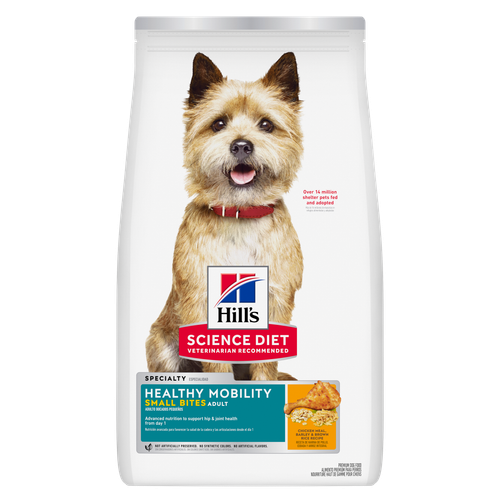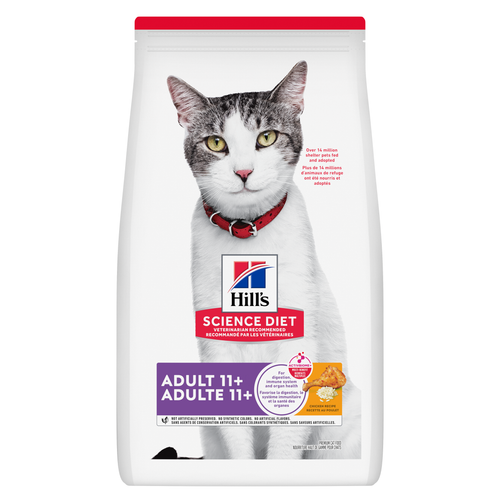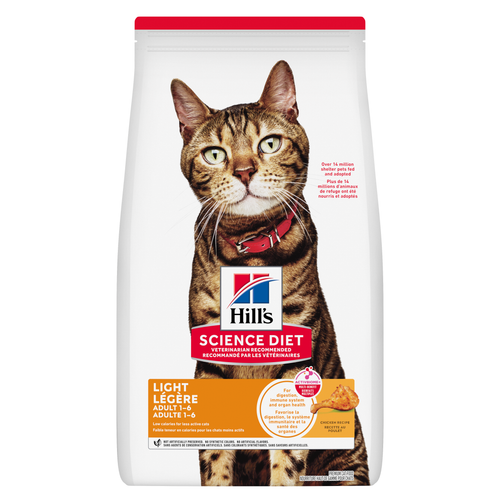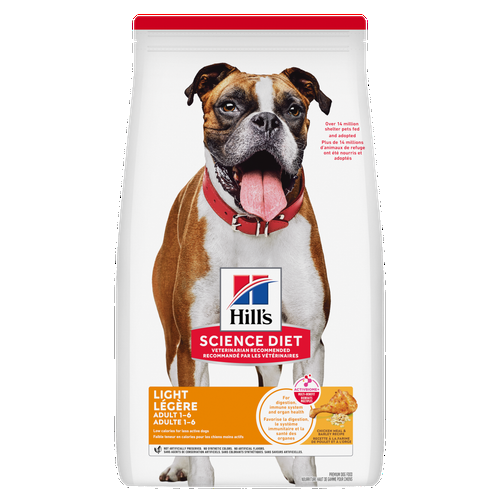
-
Find the right food for your petTake this quiz to see which food may be the best for your furry friend.Find the right food for your petTake this quiz to see which food may be the best for your furry friend.Featured products
 Adult Light Large Breed Chicken Meal & Barley Recipe Dog Food
Adult Light Large Breed Chicken Meal & Barley Recipe Dog Food18% lower calories vs. Science Diet Large Breed Adult
Shop Now Adult Sensitive Stomach & Skin Small & Mini Chicken Recipe Dog Food
Adult Sensitive Stomach & Skin Small & Mini Chicken Recipe Dog FoodHill's Science Diet Sensitive Stomach & Skin Small & Mini dry dog food is tailored nutrition for Small & Mini dogs while being gentle on stomachs. Nourishes skin & promotes a lustrous coat.
Shop Now Adult Healthy Mobility Small Bites Chicken Meal, Barley & Brown Rice Recipe Dog Food
Adult Healthy Mobility Small Bites Chicken Meal, Barley & Brown Rice Recipe Dog FoodAdvanced nutrition to support hip & joint health from day 1
Shop NowFeatured products Adult 11+ Chicken Recipe Cat Food
Adult 11+ Chicken Recipe Cat FoodSupports brain health & beautiful fur. Helps keep immune system, heart & kidneys healthy.
Shop Now Adult Healthy Cuisine Seared Tuna & Carrot Medley Cat Food
Adult Healthy Cuisine Seared Tuna & Carrot Medley Cat FoodDelicious seared tuna paired with tender carrots in a mouthwatering sauce
Shop Now Adult Light Chicken Recipe Cat Food
Adult Light Chicken Recipe Cat Food20% lower calories vs. Hill's Science Diet Adult
Shop Now -
Dog
- Dog Tips & Articles
-
Health Category
- Weight
- Food & Environmental Sensitivities
- Urinary
- Digestive
- Joint
- Kidney
- Dental
- Cancer
-
Life Stage
- Puppy Nutrition
- Adult Nutrition
- Senior Nutrition
Cat- Cat Tips & Articles
-
Health Category
- Weight
- Skin & Food Sensitivities
- Urinary
- Digestive
- Kidney
- Dental
- Stress
- Cancer
-
Life Stage
- Kitten Nutrition
- Adult Nutrition
Featured articles Importance of DHA in your Pet's Food
Importance of DHA in your Pet's FoodLearn about DHA, Docosahexaenoic Acid, a natural omega-3 fatty acid that is essential in the development of the brain and nervous system in cats & dogs.
Read More Water
WaterDiscover why water is the most important nutrient for your dog or cat to live a healthy life. Find out how much water your pet should consume each day.
Read More Antioxidants
AntioxidantsUnderstand the importance of antioxidants in your dog or cat's food, and how they can help protect your pet and keep them healthy.
Read More -


Congratulations! You've decided to bring home a second dog. The connection between your two pets is blooming, and your family is adjusting effortlessly to having another dog in the house. Unfortunately, you're finding it difficult to keep one of your dogs from eating out of both of the bowls. Is feeding multiple dogs really this hard?
Let's take a closer look at why it's important to keep feedings separate and how to feed two dogs at the same time so that they both get a healthy meal.

Why Separate Feeding Is Important
You've had many dogs in your life, so you're familiar with how often you should be feeding your pet — and how much to give them — but you never thought you'd need to learn how to keep one dog from eating the other dog's food. Yet, here you are with two pets ready for a meal, and you're not sure how to stop your one overeater from taking all the food.
As you may imagine, there are many risks to letting one dog eat out of both bowls, such as overfeeding or potentially choking on kibble that's too large. For example, if you have both small- and large-breed dogs, your larger dog will be consuming more food each day. If your smaller dog were to eat all of the bigger dog's food, not only would they overeat, but they may have trouble chewing and swallowing the larger kibble.
Some dogs may also have specific nutritional needs or may be eating a therapeutic food, and if another animal is eating their meal, one pet may not be getting the nutrient it needs whle the other may be getting an excessive amount.
The Basics on How to Feed Two Dogs
When you first begin training your dogs to eat separately, the process will mostly be trial and error. There are many options that may work, but ultimately, it's up to your dogs which works best.
First, make some changes to your routine: if you're currently allowing your dogs to share a bowl, it's time to give each dog their own bowl with pre-portioned meals. Another thing to consider is mealtime feeding only, even if you've previously left a bowl of food out each day. These two changes may seem small, but they can make a significant difference. A couple of other changes may include:
Separating and Supervising
When it's time to eat, start off by supervising your pets. Place their bowls in different locations in the same room, and keep a physical separator between the two. If your dog is overzealous but not aggressive, you can simply guide them away from the other dog's food. Bowl training may take some extra effort, but just as with any training, it's important for learning to take place.

If separating them in the same room doesn't work, or if your overeater does display signs of food aggression, you'll want to physically separate both dogs in different spaces altogether. This may mean feeding the dogs in separate rooms behind closed doors, and if you don't have fully closed-off spaces, try feeding the overeater in a crate or invest in a "baby" gate to keep them away. The food-aggressive dog will also need independent training to address this "aggresssive" behavior.


Tasty Tips
Preparing for Challenges
While separation and supervision are two of the key approaches to learning how to feed two dogs so that they can both eat, you may experience some challenges. For example, one of your pets may be a slow eater who misses out on meals when the other dog swoops in and steals their food. In this case, you have two options: you can feed the slow eater small portions more frequently in a separate space, or you can remove the fast eater to give your slow eater more time to concentrate on their meal. Some pet parents might consider taking their fast eaters out for a walk when their slow eaters are munching, or a special bowl can be used to slow down the fast eaters.
If you have a dog that is more of a grazer than one that eats all of their food quickly, you may have to reconsider leaving their food out, especially if the other dog has access to that food bowl unsupervised. Start by picking up their bowl for a half hour or hour and then put it back down to see if they're willing to eat then. You never want to leave food out and not know which dog ate it; this will quickly put pounds on a dog that eats two meals, and take away from the one that is not getting their sufficient calories.
Invest in tools that can help you when feeding multiple dogs, such as a food dispenser that controls how quickly kibble is released or a puzzle bowl. A dog who scarfs down food without pausing — and then moves onto your other pet's bowl — could benefit from the dispenser slowly giving out small portions over a longer period of time.
Learning how to feed two dogs at the same time may take some adjustment, but when you do, you'll feel confident that both pets are getting their nutritional needs taken care of. If you still have trouble, consider hiring a trainer or asking your veterinarian for some additional advice.


Erin Ollila believes in the power of words and how a message can inform—and even transform—its intended audience. Her writing can be found all over the internet and in print, and includes interviews, ghostwriting, blog posts, and creative nonfiction. Erin is a geek for SEO and all things social media. She graduated from Fairfield University with an M.F.A. in Creative Writing. Reach out to her on Twitter @ReinventingErin or learn more about her at http://erinollila.com.
Related products

Advanced nutrition to support hip & joint health from day 1

Hill's Science Diet Sensitive Stomach & Skin Small & Mini dry dog food is tailored nutrition for Small & Mini dogs while being gentle on stomachs. Nourishes skin & promotes a lustrous coat.

18% lower calories vs. Science Diet Adult

18% lower calories vs. Science Diet Large Breed Adult
Related articles

Your dog's coat and skin are a big part of your dog's overall health. Ensure you keep your dog's coat healthy, by following these simple tips.

Learn how dogs with sensitive skin can have special dietary needs, how they can develop over time in a healthy dog, and how Hill's dog food can help.

Learn basic steps & precautions for treating a cut on your dog, including what you can put on the cut, and when you should take them to the vet.

Discover how the field of dog science is giving us more and more insights into the inner workings of our furry best friends.

Put your dog on a diet without them knowing
Our low calorie formula helps you control your dog's weight. It's packed with high-quality protein for building lean muscles, and made with purposeful ingredients for a flavorful, nutritious meal. Clinically proven antioxidants, Vitamin C+E, help promote a healthy immune system.
Put your dog on a diet without them knowing
Our low calorie formula helps you control your dog's weight. It's packed with high-quality protein for building lean muscles, and made with purposeful ingredients for a flavorful, nutritious meal. Clinically proven antioxidants, Vitamin C+E, help promote a healthy immune system.

